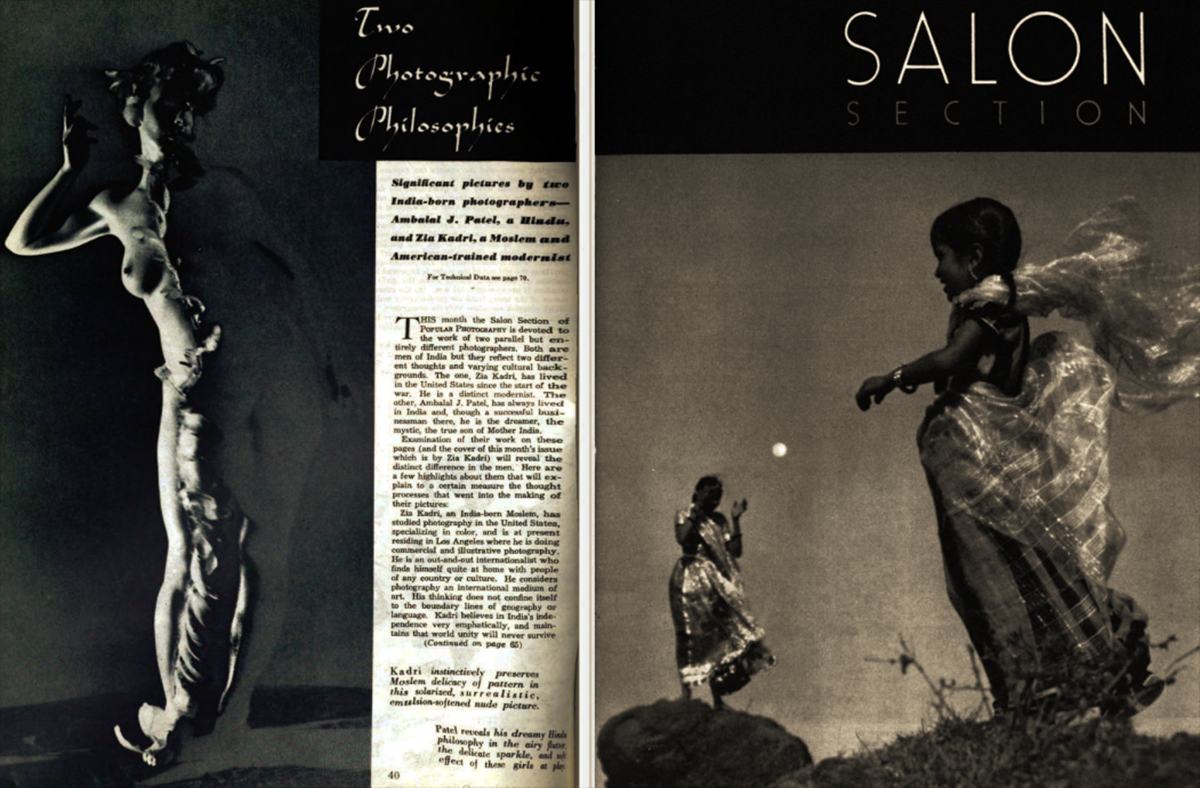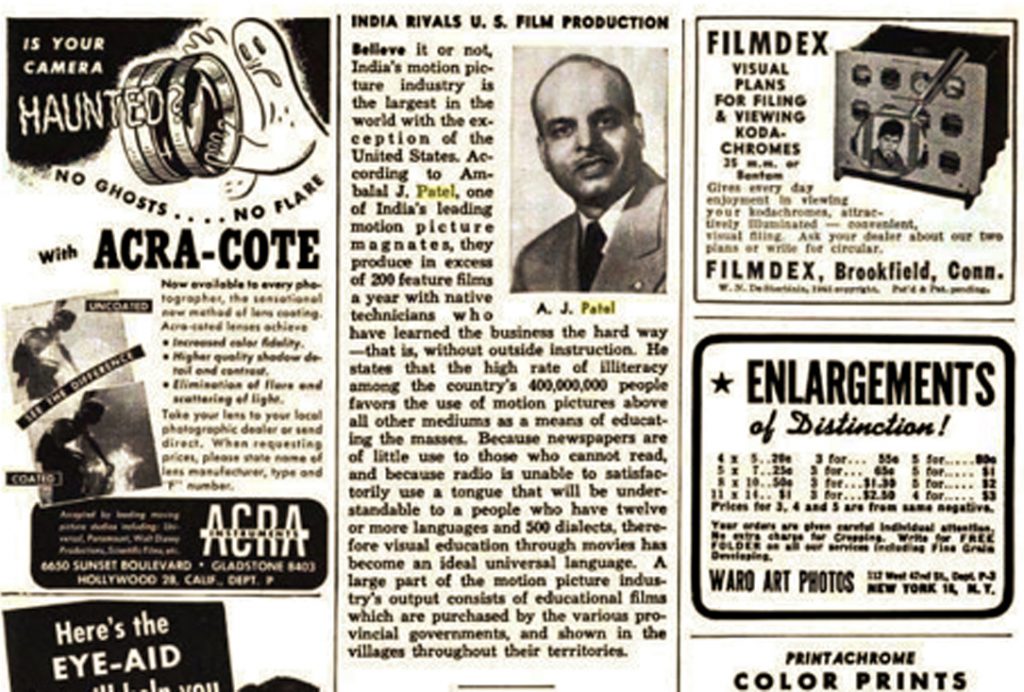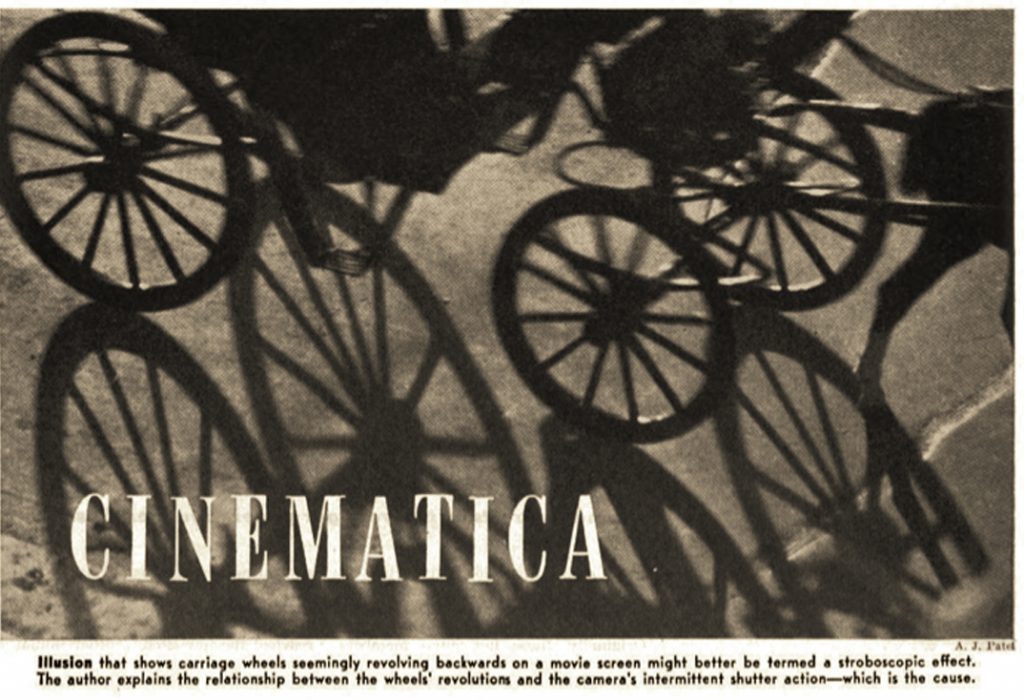
A snippet from the April 1948 issue of Popular Photography covered a visit by AJ Patel and his family to the United States and reported, “…AJ Patel, well known pictorialist, whose prints often have been hung in salons in this country, is carrying his 16mm Cine Kodak Special motion picture camera while his wife, daughter, Sindl, 11 and son, Sallit, 16, each had reflex still cameras slung over their shoulders. The group is shown during a stop-over in Chicago where they visited among other places, the editorial offices of Popular Photography.”
It Is evident from this snippet that Patel had already established prominence as a seasoned pictorialist photographer worthy of international coverage. By then, amongst other things, he had been recognised as a Fellow of the Royal Photographic Society, was a co-founder of the Amateur Cine Society, was the founding editor of the Camera in the Tropics and the owner of a successful equipment business in Bombay, the Central Camera Company. Here, I focus on his travels to the United States and its resultant influences on his magazine. There was a long and close association with Hollywood that would go on to impact a lot of the work that Patel did with film, but I shall take that up at a later stage.
Popular Photography, first published in 1937 (Camera in the Tropics was first published in 1940) was a widely circulated imaging magazine published out of New York City. The context for the setting up of the magazine, as stated by its editor Frank Fenner Jr, had been the “candid camera” craze facilitated by miniature cameras which led to a boom in the popularity and practice of photography. While the magazine was mostly focussed on advancements within North America, following the end of the war we start to see instances of magazine engaging with global practices.

This wasn’t the first instance of Patel’s mention within the magazine. In the 1945 issue, he was featured alongside Zia Qadri, another Indian photographer who had been studying in Los Angeles. Under the title “Two Photographic Philosophies”, the works of these individuals were juxtaposed as photographic practices coming from India, but differentiated by religion (the article specified that Patel was a Hindu while Qadri was a “Moslem”) and professional trajectories. Following this issue, there were several other mentions of Patel’s work, as a preeminent photographer, and later filmmaker, from India, which hint at some form of ongoing dialogue between him and his American counterparts. It is unclear how these introductions might have first happened, but this was, as we shall see, a relationship that Patel would keep alive.


Though Patel ceased to be the editor of the Camera in the Tropics, having moved on to film by then, these interactions with an international photographic community found their way into the magazine, starting in the 1950s, as contributions by international practitioners as well as featured open calls to several foreign photographic exhibitions and salons increased manifold. For example, the April 1952 issue of the magazine featured two such articles, Posing and Expression in Portraiture by Helene Sanders and Some pointers on Fundamentals by Carlyle Trevelyan. Incidentally, both Sanders and Trevelyan, were also instructors at the recently inaugurated School of Modern Photography in New York City.
Little is known about the school except that it was established in 1939, by a photographer Henry Sidel[1], who had earlier been a part of The New York Institute of Photography. According to sources, “the school promised its graduates successful careers working for magazines and the theater… It was true that some of Sidel’s students found decent jobs in journalism and show business, though most probably did not. Sidel was an astute marketer and regularly ran hundreds of advertisements in photography journals and other publications. The ads often featured the work of one of his instructors, John Hutchins, who went from “rank novice to a salon exhibitor in a little over a year,” as the New York Times noted in a profile of him in March 1939.”[2] And Popular Photography was one such magazine where the school was advertised aggressively including dedicated columns by the Director who shared news about his students, along with regular features by the instructors as well as students[3].
Apart from Sanders and Trevelyan, we see several other instructors like Leroy Crumley and Allan Fontaine, contribute to the magazine on subjects of their expertise like Portraiture, Printing or Fashion Photography. Other features that explicate the international approach the magazine was attempting include the works of Frank R Fraprie, editor American Annual of Photography, Czech photographer Adolf Rossi and portraitist Bradford Bachrach. Apart from international magazines, it is hard to ascertain other channels through which such content could have been made available for Indian readers. From its inception in India, photography in India had always been associated with Britain and occasionally Europe, but this was a moment to explore possible channels with the United States. Thus, it would be safe to assume that Patel’s connections in the United States also opened up the possibility for an exchange of ideas between Indian and American practitioners. It is also important to note that the magazine chose to invite contributions from practitioners and teachers who were interested in guiding enthusiasts on turning photography into a commercially viable professions, or in other words, give them “successful careers working for magazines and the theater.” Evidence through the magazine, of a robust intermingling between Indian and American practitioners isn’t as apparent but the fragments we have are definitely worth exploring further, which I shall pick up through the course of the project.

[1] There is some uncertainty about Sidel’s first name. Some instances mention Harry.
[2] An unlikely source for information on photographic history, the text is an excerpt from Allan Levine’s “Details Are Unprintable.” published in 2020
[3] KA Patel, who went on to be a prominent pictorialist, and later even a Hon. Editor of the Camera in the Tropics, was a student at the School of Modern Photography around 1947. Photographs by him are featured in a couple issues of Popular Photography as well.